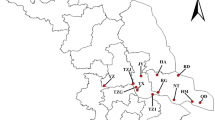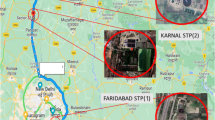Abstract
Since swine wastewater is used by farmers for soil fertilization, evaluation of toxic compounds or micro-contaminants of separate streams is required. This paper uses the toxicity identification evaluation (TIE) procedure for the physicochemical and ecotoxicological characterization of swine wastewater. To distinguish the most important toxic compounds, a physicochemical characterization and phase I-TIE procedure were performed. The acute toxic effect of swine wastewater and treated fractions (phase II-TIE) were evaluated using Daphnia magna determining 48-h LC50. Results show a high level of conductivity (23.5 μS cm−1), which is explained as due to the concentration of ions, such as ammonium (NH +4 –N 1.6 g L−1), sulfate (SO 2−4 397.3 mg L−1), and chlorine (Cl− 1,230.0 mg L−1). The acute toxicity of the swine wastewater was evaluated on D. magna (48-h LC50 = 3.4%). Results of the different water treatments indicate that anionic exchange treatments could reduce 22.5% of swine wastewater’s acute toxicity by reducing chlorine (to around 51%) and conductivity (8.5%). On the other hand, cationic exchange treatment increased acute toxicity on D. magna (% RT = −624.4%), by reducing NH +4 –N (around 100%) and total nitrogen (95.5%). This finding suggests that part of the toxicity comes from anionic compounds, such as chlorine.

Similar content being viewed by others
References
American Public Health Association (APHA), American Water Works Association (AWWA), & Pollution Control Federation (WPCF) (1985). Standard methods for examination of water and wastewater. 16th ed. Washington.
Anderson, P. D., & Weber, L. J. (1975). The toxicity to aquatic populations of mixtures containing heavy metals. Proceedings International Conference on Heavy Metals in the Environment (p 933–953), Toronto, Ontario, Canada, 1975, October 27–31.
Anthonisen, A. C., Loehr, R. C., Prakasam, T. B. S., & Srinath, E. G. (1976). Inhibition of nitrification by ammonia and nitrous acid. Journal of Water Pollution Control Federation, 48, S35–S52.
Aquatic Information Retrieval (AQUIRE). (1994). EPA ERL-Duluth's aquatic ecotoxicology data systems. Duluth (MN): U.S. Environmental Protection Agency.
Arauzo, M., & Valladolid, M. (2003). Short-term harmful effects of unionized ammonia on natural populations of Moina micrura and Brachionus rubens in a deep waste treatment pond. Water Research, 37, 2547–2554.
Blanes-Vidal, V., Hansen, M. N., Adamsen, A. P. S., Feilberg, A., Petersen, S. O., & Jensen, B. B. (2009). Characterization of odor released during handling of swine slurry: Part II. Effect of production type, storage and physicochemical characteristics of the slurry. Atmospheric Environment, 43, 3006–3014.
Burton, C.H., & Turner, C. (2003). Manure Management. Treatment Strategies for sustainable agriculture. Wrest Park (2 Ed).
Dave, G., & Nilsson, E. (2005). Increased reproductive toxicity of landfill leachate after degradation was caused by nitrite. Aquatic Toxicology, 73, 11–30.
De la Torre, A. I., Jiménez, J. A., Carballo, M., Fernandez, C., Roset, J., & Muñoz, M. J. (2000). Ecotoxicological evaluation of pig slurry. Chemosphere, 41, 1629–1635.
Emmanuel, E., Keck, G., Blanchard, J. M., Vermande, P., & Perrodin, Y. (2004). Toxicological effects of disinfections using sodium hypochlorite on aquatic organisms and its contribution to AOX formation in hospital wastewater. Environment International, 30, 981–900.
Finney, D. J. (1971). Probit analysis p. 333. Cambridge: Cambridge University Press.
Finney, D. J. (1978). Statistical method in biological assay p. 508. London: Charles Griffin & Co. Ltd.
Leung, J., Kumar, M., Glatz, P., & Kind, K. (2011). Impacts of un-ionized ammonia in digested piggery effluent on reproductive performance and longevity of Daphnia carinata and Moina australiensis. Aquaculture, 310, 401–406.
Mangas-Ramírez, E., Sarma, S. S. S., & Nandini, S. (2002). Combined effects of algal (Chlorella vulgaris) density and ammonia concentration on the population dynamics of Ceriodaphnia dubia and Moina macrocopa (Cladocera). Ecotoxicology and Environmental Safety, 51, 216–222.
Martínez-Suller, L., Azzellino, A., & Provolo, G. (2008). Analysis of livestock slurries from farms across Northern Italy: Relationship between indicators and nutrient content. Biosystems Engineering, 99(4), 540–552.
Martins, J., Teles, L., & Vasconcelos, V. (2007). Assays with Daphnia magna and Danio rerio as alert systems in aquatic toxicology. Environment International, 33, 414–425.
Moral, R., Perez-Murcia, M. D., Perez-Espinosa, A., Moreno-Caselles, J., & Paredes, C. (2005). Estimation of nutrient values of pig slurries in Southeast Spain using easily determined properties. Waste Management, 25, 719–725.
Moral, R., Perez-Murcia, M. D., Perez-Espinosa, A., Moreno-Caselles, J., Paredes, C., & Rufete, B. (2008). Salinity, organic content, micronutrients and heavy metals in pig slurries from South-eastern Spain. Waste Management, 28, 367–371.
Norberg-King, T. J., Mount, D., Durhan, E., Ankley, G. T., & Burkhard, L. (1991). Methods for aquatic toxicity identification evaluations: Phase I toxicity characterization procedures, EPA/600/6-91/003. Duluth, Minnesota: U. S. Environmental Protection Agency, Environmental Research Laboratory.
Pretti, C., Chiappe, C., Baldetti, I., Brunini, S., Monni, G., & Intorre, L. (2009). Acute toxicity of ionic liquids for three freshwater organisms: Pseudokirchneriella subcapitata, Daphnia magna and Danio rerio. Ecotoxicology and Environmental Safety, 72, 1170–1176.
Provolo, G., & Martínez-Suller, L. (2007). In situ determination of slurry nutrient content by electrical conductivity. Bioresource Technology, 98, 3235–3242.
Reyes, F., Chamorro, S., Yeber, M. C., & Vidal, G. (2009). Characterization of E1 kraft mill effluent by Toxicity Identification Evaluation Methodology. Water, Air, and Soil Pollution, 199, 183–190.
Sarma, S. S. S., Mangas-Ramírez, E., & Nandini, S. (2003). Effect of ammonia toxicity on the competition among three species of cladocerans (Crustacea: Cladocera). Ecotoxicology and Environmental Safety, 55, 227–235.
USEPA. (1993). Methods for measuring the acute toxicity of effluents and receiving waters to freshwater and marine organisms. EPA-600/4-90-027 F. Cincinnati, OH: U.S. Environmental Protection Agency.
Van Sprang, P. A., & Janssen, C. R. (1997). Identification and confirmation of ammonia toxicity in contaminated sediments using a modified toxicity identification evaluation approach. Environmental Toxicology and Chemistry, 16, 2501–2507.
Vidal, G., & Diez, M. C. (2005). Methanogenic toxicity of wood processing effluents. Journal of Environmental Management, 74, 317–325.
Acknowledgments
This work was supported by CONICYT/PBCT (Grant TPI-01) and Innova Bío-Bio (Grant 07-PC S1-198). The authors thank Mr. C. Contreras from Sucesion Yanine for use of their facilities in the realization of this study.
Author information
Authors and Affiliations
Corresponding author
Rights and permissions
About this article
Cite this article
Villamar, C.A., Cañuta, T., Belmonte, M. et al. Characterization of Swine Wastewater by Toxicity Identification Evaluation Methodology (TIE). Water Air Soil Pollut 223, 363–369 (2012). https://doi.org/10.1007/s11270-011-0864-z
Received:
Accepted:
Published:
Issue Date:
DOI: https://doi.org/10.1007/s11270-011-0864-z




